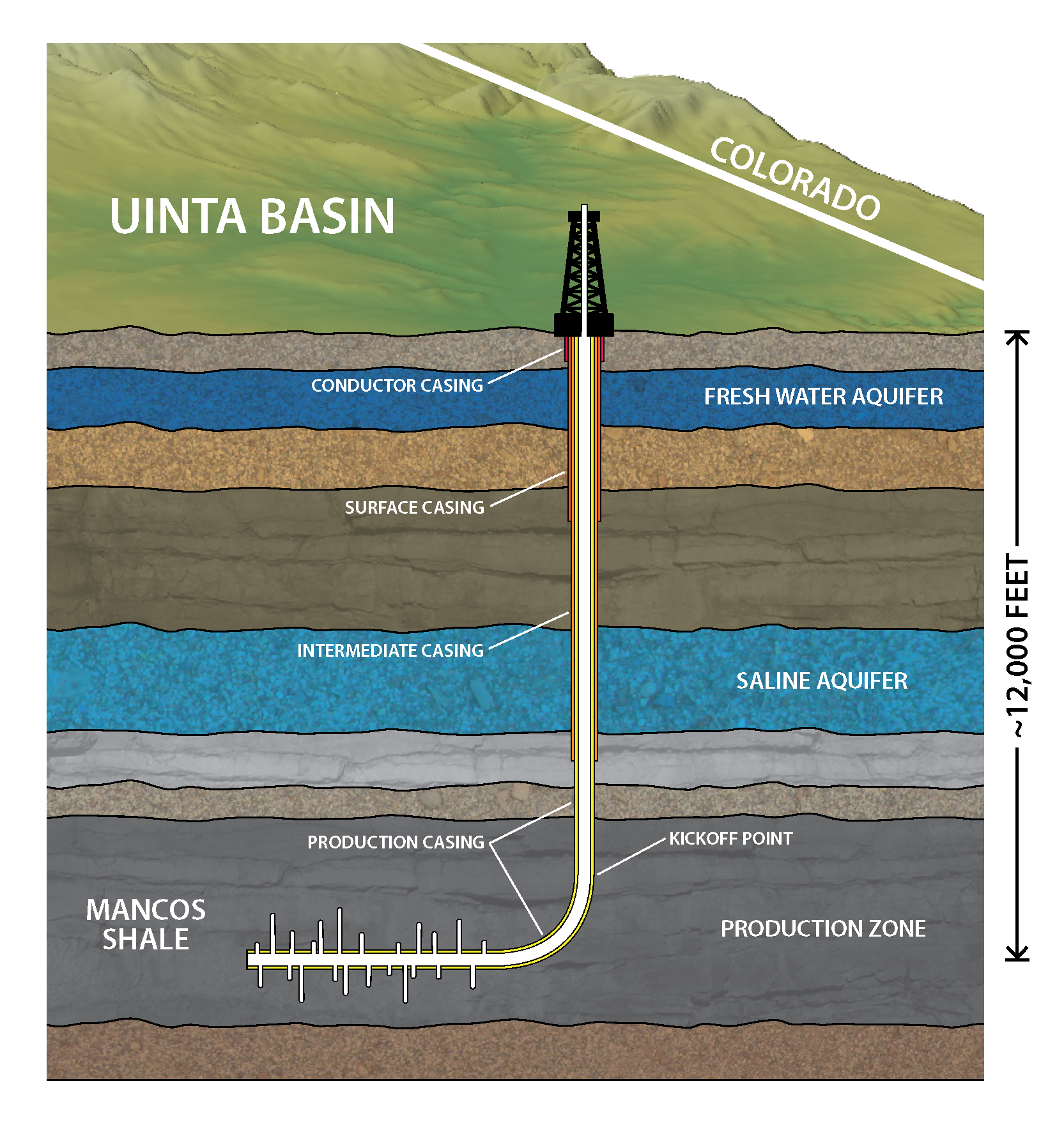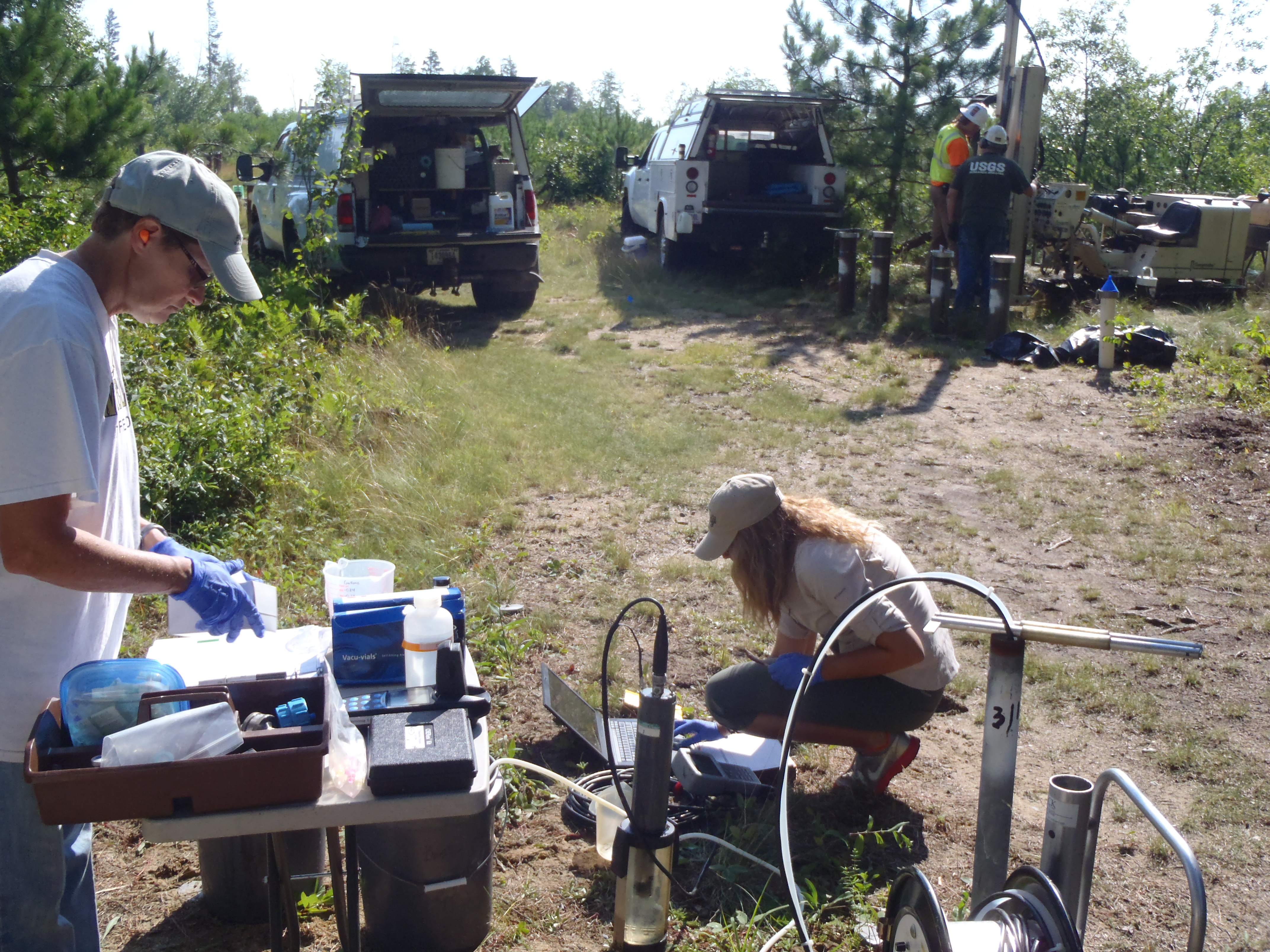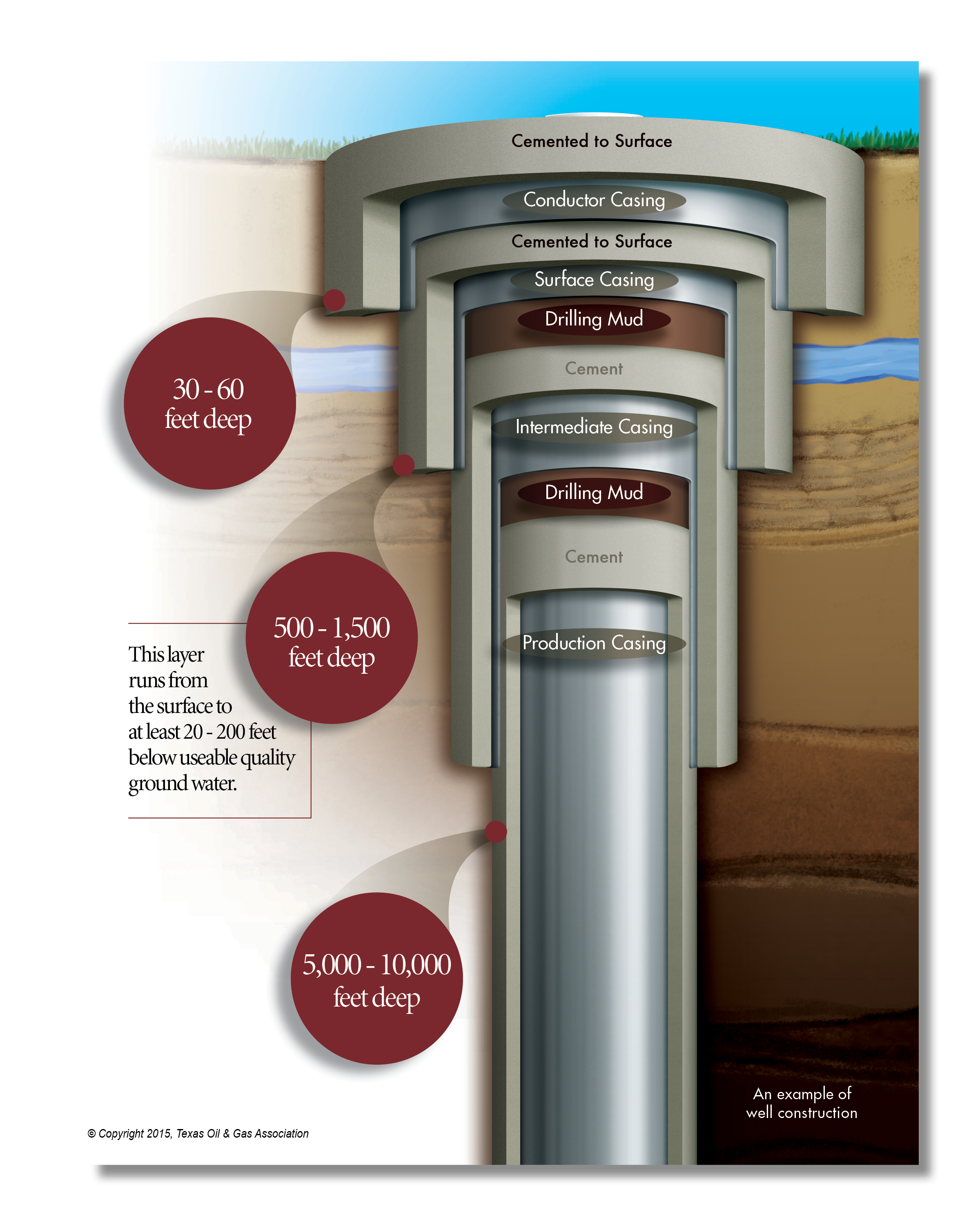Identifying and mitigating contamination of groundwater from oil and gas activity
Introduction
The United States relies on groundwater for roughly 25% of its fresh water.1 This groundwater is found in porous, permeable rocks (aquifers) that often lie close to the Earth’s surface – the deepest freshwater aquifers are found more than 6,000 feet underground,2 but most are much shallower, from near the land surface to a few hundred feet below the surface.3 In contrast, many of the largest oil and gas deposits are deeply buried many thousands of feet below the Earth’s surface. As a result, oil and gas production involves drilling through aquifers to access the oil and gas farther below. Groundwater protection techniques have long played a crucial role in protecting environmental and human health during oil and gas production. More recently, oil and gas operations, particularly hydraulic fracturing, have raised concerns about the potential for aquifers to be contaminated by methane, produced water, or hydraulic fracturing fluid. This has led to more extensive research into the mechanisms, likelihood, and prevention of groundwater contamination.
Schematic cross-section of a hydraulically fractured gas well in the Uinta Basin, Utah. The spatial relationships between the producing shale and overlying aquifers shown here are common for many, but not all, shales: operators must drill through fresh water aquifers to access the shales far beneath. Steel “casing” pipes are used to prevent the transfer of fluids between the well and the aquifer being drilled through. Hydraulically generated fractures in the shale may extend upwards for hundreds to more than 1,000 feet, but in most cases this still leaves thousands of feet of undisturbed rock between the hydraulic fractures and fresh groundwater. Image credit: Courtesy of the Utah Geological Survey.4
Potential Contaminants
Hydraulic fracturing chemicals – hydraulic fracturing fluid is roughly 99% water. The remaining 1% typically consists of 3 to 12 chemical additives that improve the effectiveness of the fluid during hydraulic fracturing operations.5 Some of these additives are toxic, and because a single hydraulically fractured well may use several million gallons of fluid, even a small leak may pose a risk to local groundwater supplies. Compositions of hydraulic fracturing fluids for most recent wells are listed in the FracFocus chemical disclosure registry,6 although some components are kept confidential except in an emergency – this confidentiality exists to protect companies’ investments in developing more effective fluids.
Drilling fluids – used to lubricate drills, remove rock chips, and maintain pressure in the well during drilling, usually consist mostly of mud and water with smaller amounts of minerals and chemicals that change the physical properties of the fluid to improve its function. Most of the substances in drilling fluids are not harmful to humans, and states typically impose restrictions on additives that can be used when drilling through freshwater aquifers. However, there have been rare cases in which unauthorized use of drilling fluid additives while drilling through freshwater aquifers has been found to contaminate groundwater.7
Methane – methane is a naturally occurring, flammable gas that is non-toxic but explosive at high concentrations. It is also a potent greenhouse gas. Methane is the main component of natural gas but it is also produced by microbes in sediments and wetlands, so methane found in groundwater may come from nearby oil and gas operations, natural microbes, both.8 Methane can also enter groundwater due to natural leakage from coal or gas-rich rocks. Determining the contributions of these different methane sources is a crucial step in assessing the environmental impacts of oil and gas production.
Oil and produced water – any fluid that can enter a well also has the potential to leak out of it if the well is compromised. This may include natural gas (see above), oil, or the often salty water that coexists with oil and gas in many rocks (called “produced water” when it is extracted along with oil and gas). Oil and saltwater leaks are rare but are of greater risk in improperly abandoned or “orphaned” wells than in active ones.9
Potential Mechanisms for Groundwater Contamination
There are three main ways in which oil and gas wells may contaminate groundwater: (1) if a well leaks (see “Preventing Well Leaks”, below), (2) if oil or other fluids are spilled at the surface (see “Spills in Oil and Natural Gas Fields” in this series), or (3) if a hydraulic fracturing operation generates cracks in the overlying rocks it is theoretically possible for fluids and/or gas to move up through the rocks and into an aquifer.
Do hydraulically generated fractures create pathways for groundwater contamination?
The horizontal and vertical extents of hydraulically generated fractures are often determined during the fracturing process. Studies of thousands of hydraulic fracturing operations in the Barnett Shale (Texas) and the Marcellus Shale (Ohio, Pennsylvania, and West Virginia) have found that hydraulic fracturing operations took place more than 3,000 feet below any aquifers, and that the fractures generated during these operations generally extended upwards for only a few hundred feet.11 A few fractures extended more than 1,000 feet, but in all cases there were still thousands of feet between the maximum extent of the fractures and the freshwater aquifers. Hydraulic fracturing for oil and gas in most areas therefore does not appear to generate fractures that allow for the migration of hazardous chemicals into freshwater aquifers. However, developing a complete understanding of these processes is an ongoing endeavor, and a procedure that is safe in one area or at one well may present risks in another.
Identifying Causes of Groundwater Contamination
Are hydraulic fracturing and/or leaking wells responsible for the contamination (primarily by methane) observed in some aquifers? This question has been extensively studied, debated, and litigated in a number of major oil- and gas-producing areas,12 including Pavillion, Wyoming;13 Dimock, Pennsylvania;14 and Parker County, Texas.15 In many cases, water quality samples were not collected prior to hydraulic fracturing, making it difficult to establish whether or not the aquifer contamination is related to hydraulic fracturing, earlier oil and gas production, or natural seepage. Most states now require (and many companies choose to conduct) pre-drilling testing of domestic and public water supplies so that the source of any future contamination can be more reliably identified.
One of the main ways in which groundwater contamination may result from oil and gas activity is if fluids spilled on the surface seep down into groundwater. Above: the area affected by the 1979 pipeline spill in Bemidji, Minnesota, is now managed by the U.S. Geological Survey (USGS), which conducts research into the long-term effects of major spills. In this picture, USGS scientists are collecting a groundwater sample from a well to monitor how the different components of crude oil that has contaminated groundwater are broken down over time by biological activity. Image credit: U.S. Geological Survey.10
Preventing Well Leaks
Oil and gas wells are constructed with multiple steel pipes (“casings”) and cement barriers to prevent leaks of oil, water, or gas into aquifers. Casing and cement also prevent contamination of the well itself by material from the surrounding rock formations. An oil or gas well can leak if the steel casing or cement are damaged or poorly constructed. This is true of all wells, old and new, whether or not they are hydraulically fractured. The U.S. Environmental Protection Agency (EPA) has found that the hydraulic fracturing process itself is not a major contributor to well leaks from oil and gas operations.12 More recent analyses have supported this finding, while also noting that surface spills are more common due to the large amounts of various different fluids being handled at and near the well site16 (see “Spills in Oil and Natural Gas Fields” in this series for more information).
Federal or state regulators specify the depth of casing and cement layers based on local geology, depth of any freshwater aquifers, and contamination risk. Some oil- and gas-producing states, such as Pennsylvania, have updated their well casing and cementing regulations since 2008 to reduce the risk of leaks into aquifers.17
Several layers of steel casing and cement are used to prevent leaks out of or into an oil or gas well. Image not to scale. Image credit: Courtesy of Texas Oil and Gas Association.
Examples of Methane Leaks from Wells
Although methane is often naturally present in aquifers, leaks from oil and gas wells are possible and may include other, more hazardous chemicals. A variety of attempts have been made to determine the number and causes of these leaks:
- The Denver-Julesburg area north of Denver, Colorado, contains about 54,000 oil and gas wells. Data from over 900 water wells in the area found dissolved methane in almost 600 of them. In the vast majority of cases, this methane occurred naturally in the groundwater due to microbial activity. However, in roughly 40 water wells measured between 2001 and 2014, the chemistry of the methane indicated that it came from leaking, often older, oil and gas wells.18 The boom in horizontal drilling and hydraulic fracturing began in 2010, but from 2010 to 2014 no increase in contamination rates was observed, suggesting that these practices did not increase well leaks.
- In the Marcellus shale area of Pennsylvania, West Virginia, and surrounding states, the picture is similar. Most methane found in groundwater is naturally produced by microbes, but in rare cases leaking wells can contaminate groundwater (see above).19
- The EPA’s 2016 assessment of the impacts of hydraulic fracturing on water resources found that hydraulic fracturing can increase the risk of leaks in poorly constructed wells. In 2007, improper cementing of a new well in Ohio and subsequent hydraulic fracturing allowed gas to enter a freshwater aquifer and then migrate into a house through a domestic water well. Accumulation of this gas caused an explosion that damaged the house.20
- Old, abandoned wells may be less well constructed and may not have been properly plugged before being abandoned. Leaks from these wells may be more likely – see “Abandoned Wells” in this series for more information.
More Resources
Ground Water Protection Council (2017). State Oil and Natural Gas Regulations Designed to Protect Water Resources. Third Edition, November 2017.
National Ground Water Association (2013). Water Wells in Proximity to Natural Gas or Oil Development. NGWA Information Brief, updated September 2017.
U.S. Environmental Protection Agency (2016). Hydraulic Fracturing for Oil and Gas: Impacts from the Hydraulic Fracturing Water Cycle on Drinking Water Resources in the United States (Final Report). EPA/600/R-16/236F.
References
1 Maupin, M.A. et al. (2014). Estimated Water Use in the United States in 2010, U.S. Geological Survey Circular 1405.
2 U.S. Geological Survey – The USGS Water Science School: Aquifers and Groundwater.
3 Alley, W.M. et al. (1999). Sustainability of Ground-Water Resources. U.S. Geological Survey Circular 1186.
4 Ressetar, R. (2012). Energy News: Hydraulic Fracturing and Shale Gas. Utah Geological Survey, Survey Notes, 44(2), May 2012.
5 FracFocus Chemical Disclosure Registry – Chemical Use in Hydraulic Fracturing.
6 FracFocus Chemical Disclosure Registry.
7 “DEP: Unauthorized drilling fluid contaminated Potter County Aquifer.” S. Phillips, NPR StateImpact Pennsylvania, October 1, 2015.
8 National Ground Water Association (2013). Water Wells in Proximity to Natural Gas or Oil Development. NGWA Information Brief, updated September 2017.
9 Kell, S. (2011). State Oil and Gas Agency Groundwater Investigations and Their Role in Advancing Regulatory Reforms, A Two State Review: Ohio and Texas. Ground Water Protection Council, August 2011.
10 U.S. Geological Survey – U.S. Geological Survey Identifies Crude-Oil Metabolites in Subsurface Plumes.
11 FracFocus Chemical Disclosure Registry – Hydraulic Fracturing: The Process.
12 U.S. Environmental Protection Agency (2016). Hydraulic Fracturing for Oil and Gas: Impacts from the Hydraulic Fracturing Water Cycle on Drinking Water Resources in the United States (Final Report). EPA/600/R-16/236F.
13 Wyoming Department of Environmental Quality – Pavillion Investigation.
14 “Last two Dimock families settle lawsuit with Cabot over water.” J. Hurdle, NPR StateImpact Pennsylvania, September 26, 2017.
15 Railroad Commission of Texas (2014). Water Well Complaint Investigation Report, Silverado on the Brazos Neighborhood, Parker County, Texas, May 23, 2014.
16 Patterson, L.A. et al. (2017). Unconventional Oil and Gas Spills: Risks, Mitigation Priorities, and State Reporting Requirements. Environ. Sci. Technol., 51(5), 2563-2573.
17 Commonwealth of Pennsylvania – The Pennsylvania Code: § 78.84. Casing standards; and §78.85. Cement standards. In: Chapter 78, Subchapter D: Well Drilling, Operation, and Plugging.
18 Sherwood, O.A. et al. (2016). Groundwater methane in relation to oil and gas development and shallow coal seams in the Denver-Julesburg Basin of Colorado. Proc. Natl. Acad. Sci. U.S.A., 113(30), 8391-8396.
19 Darrah, T.H. et al. (2014). Noble gases identify the mechanisms of fugitive gas contamination in drinking-water wells overlying the Marcellus and Barnett Shales. Proc. Natl. Acad. Sci. U.S.A., 111(39), 14076-14081.
20 Ohio Department of Natural Resources, Division of Mineral Resources Management (2008). Report on the Investigation of the Natural Gas Invasion of Aquifers in Bainbridge Township of Geauga County, Ohio.
21 Boyer, E.W. et al. (2012). The Impact of Marcellus Gas Drilling on Rural Drinking Water Supplies, Final report to the Center for Rural Pennsylvania, March 2012.
22 Baldassare, F. et al. (2014). A geochemical context for stray gas investigations in the northern Appalachian Basin: Implications of analyses of natural gases from Neogene-through Devonian-age strata. AAPG Bull., 98(2), 341-372.
23 McMahon, P.B. et al. (2017). Methane and Benzene in Drinking-Water Wells Overlying the Eagle Ford, Fayetteville, and Haynesville Shale Hydrocarbon Producing Areas. Environ. Sci. Technol., 51(12), 6727-6734.
Petroleum and the Environment
Download a full PDF of Petroleum and the Environment (free) or purchase a printed version ($19.99).
Other parts in this series:
1. Petroleum and the Environment: an Introduction
2. Water in the Oil and Gas Industry
3. Induced Seismicity from Oil and Gas Operations
4. Water Sources for Hydraulic Fracturing
5. Using Produced Water
6. Groundwater Protection in Oil and Gas Production
7. Abandoned Wells
8. What Determines the Location of a Well?
9. Land Use in the Oil and Gas Industry
10. The Pinedale Gas Field, Wyoming
11. Heavy Oil
12. Oil and Gas in the U.S. Arctic
13. Offshore Oil and Gas
14. Spills in Oil and Natural Gas Fields
15. Transportation of Oil, Gas, and Refined Products
16. Oil Refining and Gas Processing
17. Non-Fuel Products of Oil and Gas
18. Air Quality Impacts of Oil and Gas
19. Methane Emissions in the Oil and Gas Industry
20. Mitigating and Regulating Methane Emissions
21. Regulation of Oil and Gas Operations
22. Health and Safety in Oil and Gas Extraction
23. Subsurface Data in the Oil and Gas Industry
24. Geoscientists in Petroleum and the Environment
Glossary of Terms
References
Naturally Occurring Methane in Aquifers
In oil- and gas-producing areas, the presence of methane in aquifers can cause significant local concern over the safety of oil and gas operations. In many cases, however, methane is naturally present in the local rocks and soil:
- In the Marcellus shale area of Pennsylvania, West Virginia, and parts of adjacent states, methane was commonly found in aquifers before any hydraulic fracturing took place in the area. Measurements taken before nearby hydraulic fracturing activities began found methane in 24% of 189 water wells in Pennsylvania.21 Pre-drilling methane contamination in the Marcellus region is caused by both microbial activity and the slow, natural leaking from gas-rich rocks in the area.22
- A 2017 study by the U.S. Geological Survey found that in the main natural-gas-producing areas of Texas, Louisiana, and Arkansas, most methane found in water wells is produced by microbes, not leaking gas wells.23 This was determined by studying the chemistry of the methane and associated gases, which can be used to distinguish microbial methane from natural gas.




